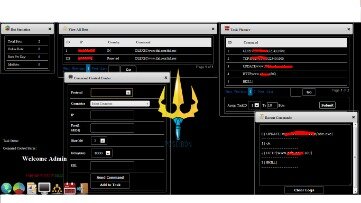Bitcoin Botnet Hack Forums Gamertagsfind Best Vehicle Tracker
Content
We then showed that the security-efficiency ratio decreases with increasing miner heterogeneity. Any market distortion that increases miner heterogeneity will lower the security-efficiency ratio. Consequently, an increase in the number of potential miners increases the dissipation ratio, drives down the expected payoffs, and ultimately leads to a seigniorage of 0. However, in the case of homogeneous miners we have shown that any expenditures positively affect network security φ to the same extent. As shown in Equation we define network security as the minimum of all marginal costs multiplied by the network hash rate. In other words, φ is equivalent to the minimum cost an individual would have to bear to control half of the computation power and launch a surprise attack on the network.
The Windows version contained some extra capabilities from normal Mirai botnets such as SQL injection and brute-force attack tools, but the new ELF Linux/Mirai malware variant boasts an extra add-on in the form of a bitcoin miner slave. According to a 2016 study by the security firm BullGuard, up to 185 million devices may be at risk of being compromised by Mirai. Hackers used the network of compromised devices in a series of attacks that caused several major websites to go offline, including Netflix, Reddit and Twitter. IBM researchers discovered a bitcoin mining component in a new variant of Mirai—a form of malware that exploits security vulnerabilities to take control of devices connected to the so-called Internet of Things . Additionally, we demonstrated how the introduction of a botnet affects the network. We concluded that botnets decrease the security-efficiency ratio and may even lead to dissipation ratios above 1.
They conclude that it is possible to isolate roughly half the mining power by hijacking less than 100 prefixes. They also show that a large number of hijacks targeting Bitcoin nodes are happening regularly (however, a longitudinal analysis in below found that this kind of hijacks is just misconfiguration). Some deployable countermeasures were proposed, including both short-term and long-term patches. This is a control-plane attack, which utilises the routing manipulation to intercept Bitcoin traffic from/to the victim nodes directly. The high-level idea is using BGP hijacking to seize control all of the most-specific IP prefixes (up to /24) pertaining to the victims; in particular, they are prefixes containing the IP address of the targeted nodes. Then, by controlling all the victim’s inter-domain routes, the adversary can arbitrarily drop/modify/delay Bitcoin messages pertaining to the victim.
Mastercard Will Soon Support Cryptocurrencies, But Bitcoin May Not Be One Of Them
The British government has published its Integrated Review into defence and security policy – and though you’ll like it if you’re in the UK infosec industry, threats of nuking North Korea in revenge for WannaCry are very wide of the mark. OpenAI is building a content filter to prevent GPT-3, its latest and largest text-generating neural network, from inadvertently revealing people’s personal information as it prepares to commercialize the software through an API. As a reminder, a fresh security update dropped from Microsoft’s Windows Update orifice last week that left some Windows 10 users unable to print. Worse, a screen of deathly blue was flashed when a printing operation was attempted – a step up from the error message seen after last year’s mishap.
The global higher education sector has seen a sharp increase in potentially damaging cryptocurrency mining behaviours with universities the target of more than half of known attacks. Academic networks in Asian countries are the most heavily targeted, followed by institutions in North America and Europe, a new report has found.
1 Homogeneous Miners
The task requires solving complex mathematical calculations called proof of work, and its complexity is meant to prevent devaluation of the currency. Harry Denley, director of security at MyCrypto, discovered the scheme hosted on nine websites. According to the report, some $45,000 in bitcoin has been stolen in the last month.
- By using we can eliminate h in and re-express the equation, as shown in Equation .
- That online zombie horde was capable of launching coordinated cyberattacks, cracking passwords, or mining hundreds of dollars a day worth of cryptocurrency.
- However, at the time of publication, no exploits for these vulnerabilities have been observed in Prometei’s attack chain.
- In reality, this is essentially how a botnet operates – and it’s one of the most insidious forms of malware in use today.
This suggests Prometei may be a combination of a number of underlying tools from disparate creators. Prometei will also attempt to propagate to systems on the network using the same set of exploits used to gain initial access. A modified version of the Mimikatz credential stealer is also used to obtain SMB or RDP account details which can then be used for lateral movement. There is also evidence Prometei’s operators are attempting incorporating SMBGhost and SMBleed exploits.
Step Up Your Cybersecurity Game With Get Support
We will first present the base model and discuss the case of N̄≥2 homogeneous miners. We use this model to define the terminology and introduce our measure of network security.
Other than mining Cryptocoins this distributed super computer could easily be used for other purposes such as password cracking, DDoSing or doing any other large scale parallel task. But this time it’s not malware based, a pair of researchers realised they could automate the sign-up to multiple cloud providers and leverage the free tier/free trial/freemimum accounts to mine Cryptocurrency . This is a pretty interesting story, and an interesting use (or mis-use) of cloud resources. We’ve covered similar stuff before like the case when Yahoo! was Spreading Bitcoin Mining Botnet Malware Via Ads, and then more recently when the Pirated ‘Watch Dogs’ Game Made A Bitcoin Mining Botnet. Although not considered by experts to be as dangerous as a targeted cyberattack, cryptocurrency mining still puts personally identifiable information, protected health information and financial data at risk, says Vectra.
What is the business impact of botnets?
Application Denial of Service
Competitors or fraudsters use botnets to illegally access your website and mobile application’s critical services. This impacts performance, user experience, brand reputation, revenue and ultimately loss of genuine users.
“This led us to question the effectiveness of a bitcoin miner running on a simple IoT device that lacks the power to create many bitcoins, if any at all,” McMillen writes. “Given Mirai’s power to infect thousands of machines at a time, however, there is a possibility that the bitcoin miners could work together in tandem as one large miner consortium. Unfortunately for the cybercrooks, however, it seems that a botnet-turned-mining rig doesn’t actually make much money in real life. McAfee found that the increasing difficulty of Bitcoin hashes, combined with the attrition rate from malware detections on infected machines, would make turning a profit from botnet mining nearly impossible. Security giant McAfee contends in its quarterly threat report that commercial botnet controllers and malware packages have been adding cryptocurrency mining options to their list of services offered. Despite an increase in popularity over recent months amongst botnet operators, malware-powered Bitcoin mining brings little to no financial return, say experts.
Some countermeasures are proposed for mitigating this attack, and some of these are being implemented by the Bitcoin developer team. However since the attack does not exploit any particular vulnerabilities of the Bitcoin core, it is still hard to eliminate Erebus completely. This attack exploits a vulnerability in the internal IP table management and peer selection mechanisms of Bitcoin nodes to arbitrarily insert malicious IP addresses into the IP table, eventually evicting all legitimate ones. It allows any adversary who controls a large enough range of IP address to monopolise all of the victim’s inbound and outbound connections. After occupying enough slots in the victim’s IP table, the adversary triggers the node to restart; then there is a high probability that the victim node will establish all of its new connections to IP addresses controlled by the attackers.
However, Seaman notes that this particular cryptoming botnet campaign has been functioning for over three years, during which it has mined Monero worth more than $30,000. As shown in the proof of Proposition 4, the presence of a botnet may cause the dissipation ratio to exceed 1. However, recall that the dissipation ratio is not a sufficient measure for our purposes, as it contains no information regarding the nature of the cost. In order to get an objective comparison, we need to reconsider the security-efficiency ratio, which was introduced earlier in this paper.
Once in, it executes configuration changes allowing the hackers to run malicious commands and download malware binaries. This white paper details 7 case studies of attacks that were intercepted and neutralised by Darktrace cyber defense AI, including a zero-day trojan in a manufacturing company’s network. Learn how Darktrace Antigena AI Response modules fight back autonomously, no matter where a threat may emerge, extending to the Cloud, Email and SaaS.
“We got a terabyte for free on one service,” said Ragan, “which is more than you can even pay for.” “These cloud based services do many different things,” said Salazar, “but the purpose is to let developers get something up and running immediately.” “It cuts out all the legwork and lets you build an application as quickly as possible,” added Ragan. “Platform as a service is a commodity that’s in high demand. But if it’s making the life of a developer easier, wouldn’t it also make things easier for a malicious attacker? That’s exactly what we explored.” It is shown that the attack is feasible for large AS/ISPs, only needs a few weeks of execution and can be executed with a trivial traffic rate. The authors note that a range of top cryptocurrencies share the Bitcoin core codebase, and a significant number among them are still using out-of-date code, making them potentially vulnerable to the Erebus attack. By showing that distributed permissionless ledgers still rely heavily on the current Internet infrastructure, the paper reminds us that blockchain systems may be insecure against powerful AS-level adversaries.
Let us now consider a special type of miner whose marginal costs are larger than its expected marginal profits. Although puzzling at first, this type of miner may exist for a number of reasons including “hobbyists and researchers,” “wishful thinkers,” “botnet operators,” “political actors,” and “individuals looking for a virgin coinbase” . In our analysis we will focus on botnets, but the following model could be used to describe situations with any of the actors described above.
The client-server botnet relies on a central location through which the “bot master” controls all devices on the network. This location is usually an Internet Relay Chat server, a domain (like example.com), or a dedicated website. Bitcoin mining, which utilises the processing power of the infected machine to make complex calculations which result in the creation of bitcoin currency for the owner of the botnet.
Obviously, this has the effect of decreasing the miners’ respective probabilities to win the competition and hence, has a negative impact on their expected payoff. Let us now combine the two, and introduce a measure, henceforth referred to as the security-efficiency ratio. It expresses the proportion of expenditures that serves to protect the network and hence, combines both the network’s security and efficiency in one measure. Most recently, it was responsible for a massive 54-hour attack on a US college which generated the highest traffic flow that security firm Imperva Incapsula had ever seen out of a Mirai botnet.
Let us adjust Equation to account for the botnet and divide it by to obtain Equation . The equation for the dissipation ratio must be slightly adjusted to , to include the social cost inflicted by the botnet. As shown in Equation , we need to adjust the miners’ expected payoff function by including the botnet’s hash rate.
In reality, this is essentially how a botnet operates – and it’s one of the most insidious forms of malware in use today. Because of the distributed nature of a botnet, they can be difficult to eliminate – but that doesn’t mean your business can’t protect itself from becoming part of a compromised network. Plugging into , we get , which expresses the security-efficiency ratio with endogenized hash rate allocation decisions. The above expression allows us to demonstrate how the dissipation ratio changes in the presence of a botnet. In the absence of any barriers to entry, potential miners will enter the market until the last bit of seigniorage is absorbed by the increasing hash rate.
Consequently, systems that are more susceptible to botnet capture, such as ASIC-resistant proof-of-work implementations, may be more prone to these inefficiencies under the assumption that all other hashrate providers face the same cost. We have proposed a model that allows for the evaluation of the efficiency of proof-of-work mining under different circumstances by categorizing the allocated resources as either useful or wasteful. The model also shows how security and efficiency are affected by miner heterogeneity. To relate those two values, we proposed the security-efficiency ratio, a value that expresses the portion of the aggregate expenditures that is used to secure the blockchain.
The implications of those attacks can vary, from selfish mining leading to a majority attack and double-spending, or even worse, a service denial attack that takes down a cryptocurrency. This post is also published on Security Research Blog, University of Cambridge and Medium. People have tried to develop many different attack vectors on cryptocurrencies, from codebase flaws, cryptographic algorithms, mining processes, consensus protocols and block propagation mechanisms to the underlying network layer. “Students’ online activities through the use of untrusted websites that host crypto-mining malware could represent the indirect weak backdoor to attack universities’ high-bandwidth capacity networks,” Alfrmawi said.













